#cancridae
Photo
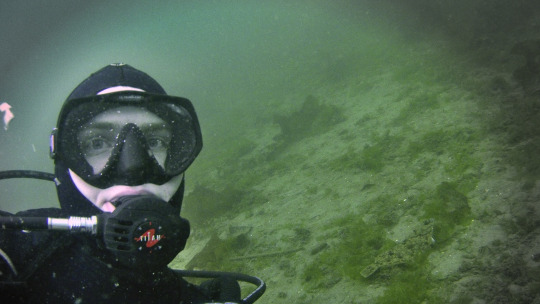

Shellfies with a handsome rock sole (Lepidopsetta bilineata) and a red rock crab (Cancer productus)
#cancer productus#red rock crab#lepidopsetta bilineata#rock sole#flatfish#crab#brachyura#cancridae#pleuronectodae#puget sound#pnw#whulge#underwater photography#scuba#diving#wa#washington#marine biology#tacoma#les davis#salish sea
101 notes
·
View notes
Note
I see!
Completely and totally unrelated, but the aforementioned tattoo wouldn’t happen to be a cancridae crab, would it~? Purely out of curiosity, of course.
-🧺

cancridae, kankridae, something like that.
motherfucker, so smug.
#ic#ampora#homestuck#musings#cronus ampora#my art#hs cronus#cronus#answered#anonymous#i hate him sometimes
4 notes
·
View notes
Text
Cancer no longer exists!
The genus, I mean. It’s all family Cancridae now. What else could I mean
4 notes
·
View notes
Note
can i get a talksprite of buff karkat with horns on his forehead, red eyes and long pointy ears. and he's wearing a normal black t shirt with his sign!
i hope you like the him


- mod dave
6 notes
·
View notes
Photo

Jonah crab (via U.S. Fish and Wildlife Service Northeast Region)
Monomoy National Wildlife Refuge, MA. Credit: USFWS
#Jonah Crab#Cancer borealis#Cancer#Cancridae#Brachyura#Decapoda#Malacostraca#Crustacea#crab#crustacean#beach#Monomoy National Wildlife Refuge#Monomoy NWR#Cape Cod#Massachusetts
19 notes
·
View notes
Photo


Graceful Crab (Metacarcinus gracilis)
#metacarcinus gracilis#graceful crab#crustacean#brachyura#cancridae#pnw#wa#washington#puget sound#salish sea#whulge#les davis#tacoma#crab#underwater#photography#scuba#diving#ocean#marine biology
91 notes
·
View notes
Photo
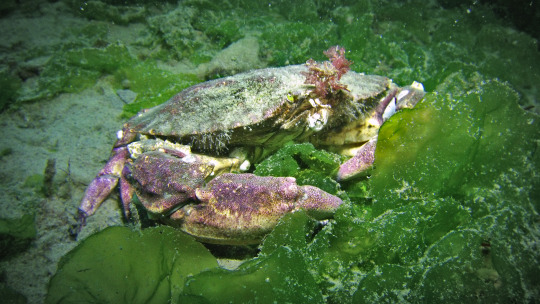
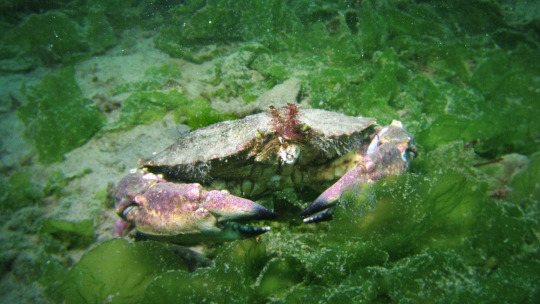

Red Rock Crab (Cancer productus)
#cancer productus#red rock crab#brachyura#cancridae#underwater#photography#scuba#diving#pnw#wa#washington#les davis#tacoma#ocean#marine biology#crab#crustacean#whulge#salish sea
81 notes
·
View notes
Text

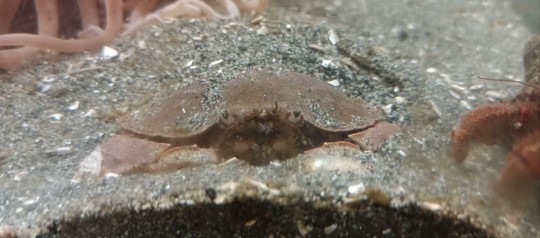
Our Cancer productus and one of our Metacarcinus gracilis. Cozy as a crab!!!! 🦀 🛏️
#mast center aquarium#graceful crab#red rock crab#cancer productus#metacarcinus gracilis#crab#crustacean#decapod#brachyura#cancridae
20 notes
·
View notes
Video
youtube
In this expedition, I found a group of 20 red rock crabs (Cancer productus), plus a dungeness crab (Metacarcinus magister). An amazing find.
#eukarya#animalia#arthropda#crustacea#decapoda#cancridae#cancer productis#metacarcinus magister#crab#invertebrate#invert#rov-e6-4-23#lobster shop wall#tacoma#ruston#was#washington#puget sound#commencement bay#malacostraca#pleocyemata#brachyura#cancer productus#c. productus
11 notes
·
View notes
Text

Red Rock Crab (Cancer productis)
#red rock crab#eukarya#animalia#arthropoda#crustacea#malacostraca#decapoda#pleocyemata#brachyura#cancridae#cancer#cancer productis#c. productis#crab#crustacean
7 notes
·
View notes
Text


She feasts
3 notes
·
View notes
Text

Oh, to be cradled on the sandy sea floor by a big male after molting 🥺🥺🥺
#eukarya#animalia#arthropoda#crustacea#malacostraca#decapoda#brachyura#cancridae#metacarcinus#metacarcinus magister#aka the dungeness crab#crab#crustacean#shitpost#meme#big male
10 notes
·
View notes
Text
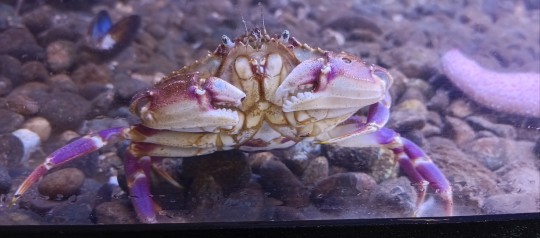
This is Gracie, one of our graceful crabs*(Metacarcinus gracilis)* at the aquarium. She decided it would be fun to walk up to my scraper and attack it.
#eukarya#animalia#arthropoda#crustacea#decapoda#cancridae#metacarcinus gracilis#graceful crab#mast center aquarium
4 notes
·
View notes
Video
youtube
Parophrys vetulus, Lepidopsetta bilineata, Citharichthys stigmaeus, Metacarcinus magister, Metacarcinus gracilis, penpoint gunnel, crescent gunnels, unidentified sculpin, jellyfish, and more can be found beneath the surface of Les Davis Marine Park!
The park is most notable for its concrete reef, located about 18m down near a marker buoy. I did not visit the reef, unfortunately, due to low visibility conditions that made me uncomfortable going deeper than 9m. Perhaps next time I will record a definitive set of wildlife seen on the reef! Among them are rockfish, lingcod, and Metridium farcimen in the hundreds!
#parophrys vetulus#lepidopsetta bilineata#cancer productus#metacarcinus magister#metacarcinus gracilis#red rock crab#graceful crab#dungeness crab#flatfish#cancridae#pleuronectodae#crabs#jellyfish#nudibranch#sculpin#scorpionfish#cnidarians#pnw#wa#washington#whulge#salish sea#les davis#tacoma#underwater#photography#videography#scuba#diving#penpoint gunnel
1 note
·
View note
Link
34.7% survival rate of high CO2 crabs.J

(A juvenile Metacarcinus magister hiding in the sand)
In this study, the authors aimed to explore the population-level impact of ocean acidification/high CO2 concentration on Dungeness crabs (Metacarcinus magister) during their juvenile life stage. At present, the mean pH level of Puget Sound, where this crab is native to, is 7.8, with some areas reaching 7.2. In this experiment, 222 M. magister megalopae were split up into two different chambers. The ambient chamber best resembled current pH level of Puget Sound (an, in fact, water was pumped directly from the Sound into the chambers), and sat a 400ppm of dissolved CO2. The high acidity chamber was maintained at 2800ppm of CO2, quite the increase. Over 327 days, the crabs were measured and weighed, and the results were bizarre.
Ocean acidification is proving to be a serious issue affect marine ecosystems. The effects of elevated CO2 on invertebrates species have been studied, but there is much more to do. M. magister zoea were discovered to suffer as a result of increased dissolved CO2. The next step was to determine how it affected later stages in life.

(A M. magister zoea)
Despite the megalopae being near ready to transition to juveniles at the time of capture and at the beginning of the experiment, megalopae survival rate in both chambers were above 95%. They appear to be resilient to higher CO2 concentrations, but given the brief exposure period of several days before transition, nothing definitive can be established.

(M. magister megalopae)
The juveniles who were kept in the high CO2 chamber actually had a greater survival rate than the crabs in the ambience chamber. But they also did not grow as large as their ambient conspecifics. In addition, high acidity crabs molted faster from stage J5 to J6 (J meaning juvenile, with the number representing the number of molts thusfar). High acidity crabs also had a higher resting metabolic rate, though the rate decreased as they progressed through molting stages. There was no significant difference in weigh, but shape was also influenced, with ambient crabs being 9% longer at stage J6.

Between stages J1 and J2, ambient crabs were over four times more likely to perish. Of the 99 crabs subjected to ambience CO2, only 18.9% survived to the end, as opposed to the 34.7% survival rate of high CO2 crabs, meaing the odds of dying were twice as high in ambient levels.

The authors propose three hypothesis’ to explain the results. The first is the cryptic pathogen hypothesis. Based on research from other biologists, they deemed it probable that some unknown (and untested for) pathogen carried in from the Sound had a harder time surviving in the high-acidity chamber, which allowed those crabs to be exposed to a lesser number of the pathogen. Inversely, crabs in the ambient chamber were fully exposed to the pathogen, thus reducing survivability.
Microbial abundance can decrease in high CO2 concentrations, and evidence from a study on oyster parasites shows that low pH levels resulted in a decline in the parasite’s numbers. Virus’ are also less abundant in low pH environments.
Though in contrast to all this, crabs have actually displayed a suppressed immune response when exposed to high CO2 levels. The only major difference in survival of the crabs was the first molt, which would suggest that the pathogen weeded out the unfit and had a harder time affecting the remaining population. It could also mean that crabs are more vulnerable at J1. The last explanation is that the pathogen was snuffed out in the later stages of the experiment.

The second hypothesis is that juveniles are adapted to survive in acidic environments. The pockets of low pH water and the generally more acidic conditions of the substrate they hide in would support this. However, this would imply that juvenile M. magister would struggle in low-CO2 environments. This is a counter-productive trait. Another point against this hypothesis is that the high-CO2 environment had negative physiological effects on the crabs, such as the high metabolism and smaller size. Since this species is susceptible to cannibalism, any trait that would inhibit the natural defense of being larger would be selected out.
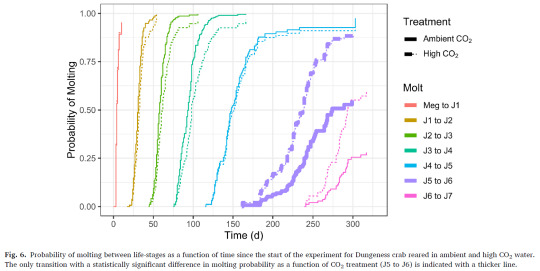
The third and last hypothesis is that a strange combination of physiological trade-offs were at play, though for the reasons above, this is also speculative and likely. This leaves the first hypothesis as the most likely. Should the opportunity to reproduce the experiment present itself, the chamber’s water should be regularly examined for signs of pathogens.

The metabolic rate is another area that warrants investigation. A potential explanation of the increased metabolism observed in high-acid crabs is that there is a greater physiological cost associated with maintaining an internal pH balance that is further from the pH of the environment.

To conclude, high-CO2 levels had a positive impact on survival rate, but a negative impact of growth rate. in the wild, the protection from pathogens offered by acidic water would has little impact.
Higher CO2′s relatively minute effects on juveniles rules out this stage of the specie’s life being an indicator for ecological impact of ocean acidification of the population; despite the smaller overall size potentially resulting in increased vulnerability to predation.
Megalopae appear to be resilient of acidification. Zoea remain the most vulnerable stage of M. magister.
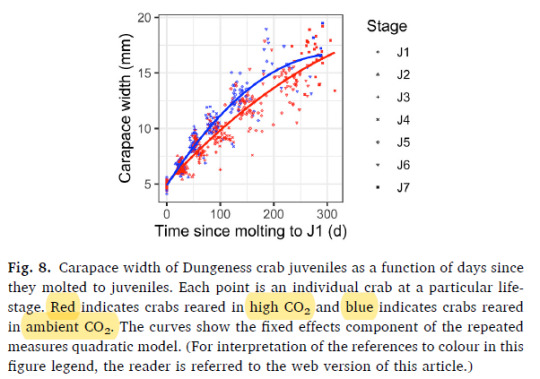
Overall, it was a fascinating paper, even if the statistical methodology section literally put me to sleep.
#metacarcinus magister#m. magister#dungeness crab#eukarya#animalia#arthropoda#brachyura#crustacea#pleocyemata#cancridae#2022#puget sound#paul mcelhany
0 notes